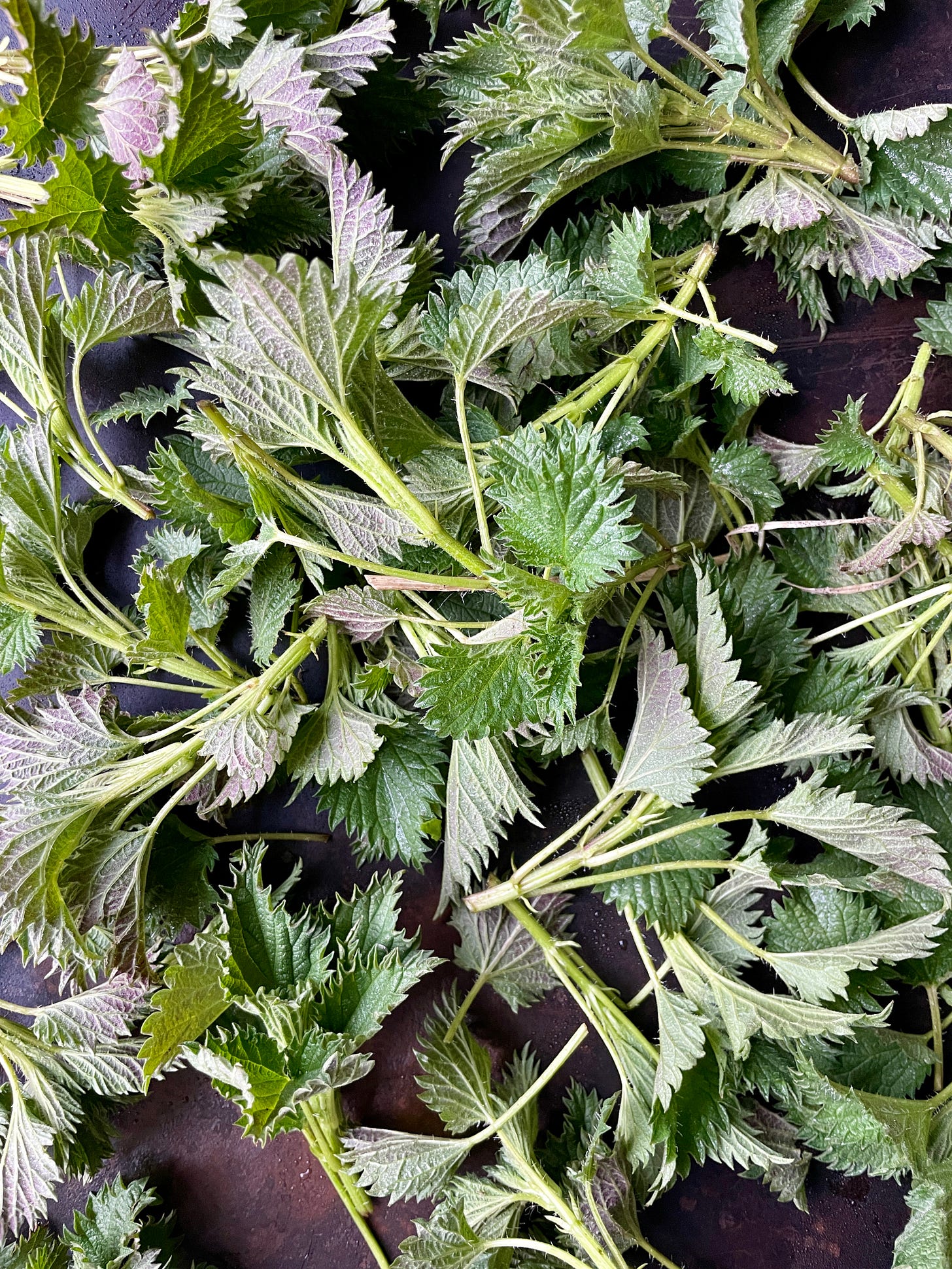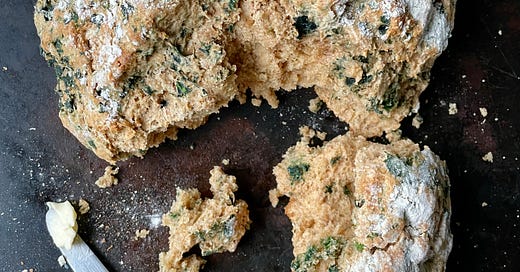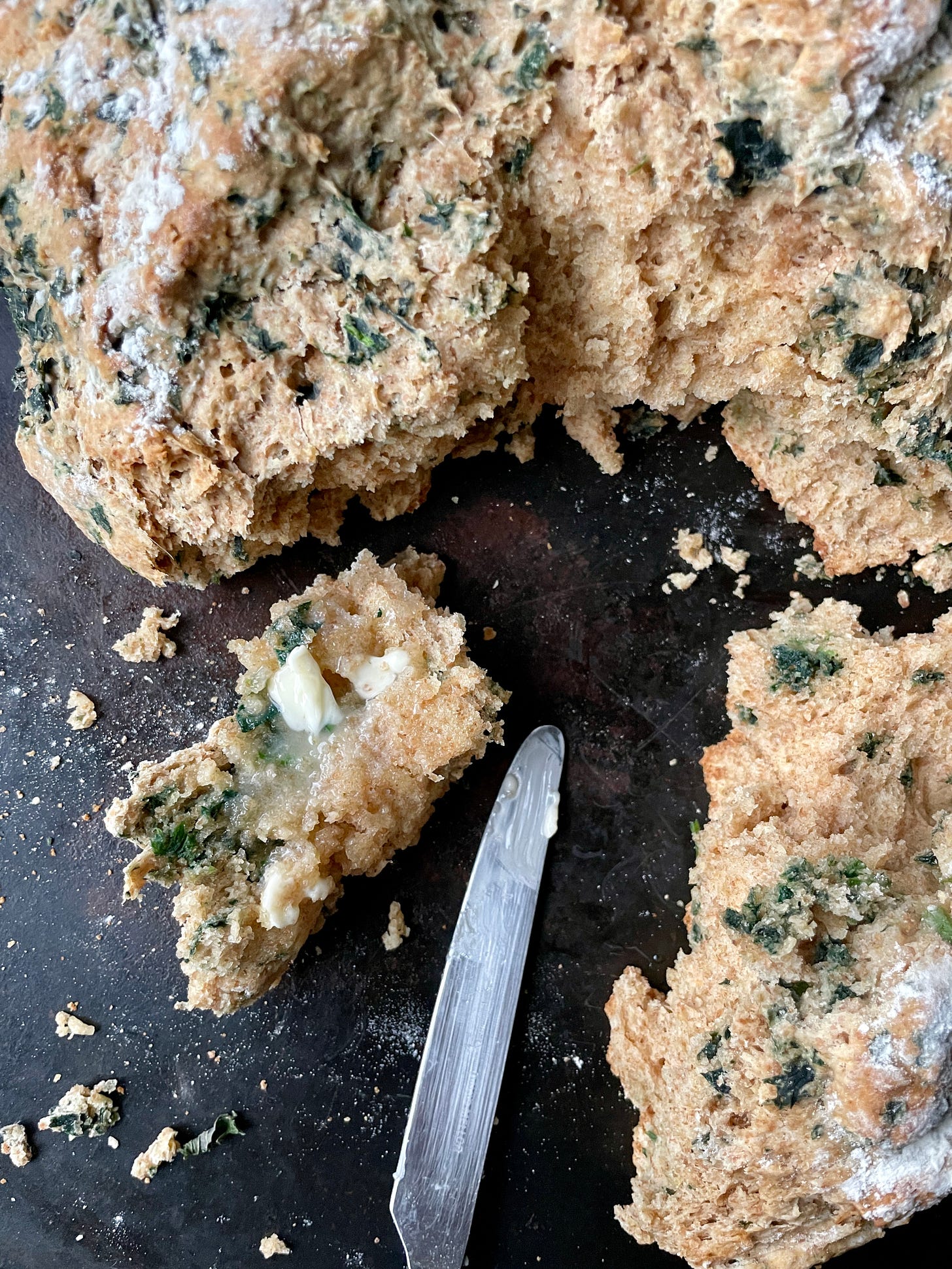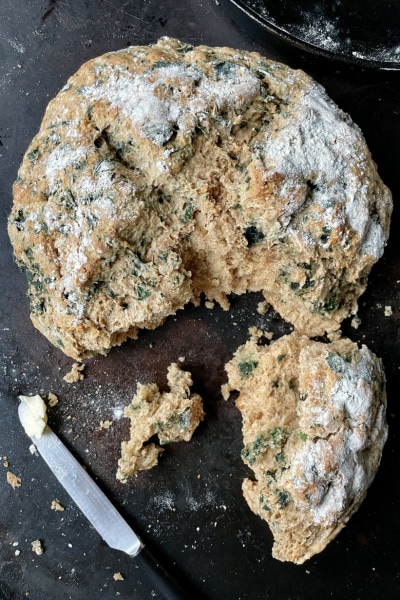A few weeks ago, I teased you with a gorgeous photo of an Irish soda bread in my St. Paddy’s day newsletter, and didn’t provide a recipe! I realized my mistake right away, and, indeed, many of you requested it.
Since this was from a workshop back in 2015, we all had to jog our memories to remember what it was exactly. My friend Cliodhna Prendergast had made it as a sort of double-duty prop and snack for that day, and when Imen McDonnell and I were trying to recall what it was, we concluded that it had dillisk, the local seaweed, which is another word for dulse. Though you could indeed use it to flavor a savory version of Irish soda bread, I’ve since realized that the soda bread contained nettles, not dulse.
Do you know what nettles are? Often referred to as “stinging nettles,” they are one of the earliest things to pop up out of the ground this time of year. Maybe you have a patch of them in your backyard? I have a patch that no one but me seems to know about at our CSA, Quail Hill Farm. I marched over there, as I do each spring, wearing my rubber gloves the other day so that I could try to replicate Cliodhna’s soda bread for you. You might also find nettles sold in bunches at your local farmer’s market. Just remember they do have a stinging quality, so you’ll want to protect your hands until you get them into boiling water for a quick blanch before using.

When my husband walked into the kitchen yesterday and saw my first attempt, he said, “You made that? Today?” He was impressed. It is VERY quick and easy. If you can’t find nettles, you can still make this bread on a whim. I decided to add chives for my second version, because my herb pots are already overflowing with them. But another good idea would be to use sliced scallions. You could throw in some chopped soft herbs too or use dried dulse.
You can likely find dried dulse in the “health food” section of your supermarket. Just soak until soft, squeeze and blot out the water, and chop finely.
If you’re having an Easter gathering, you can easily put this together just beforehand, so you can serve it warm. It’s delicious fresh from the oven slathered with butter, and also good toasted. Either way, it would be a great place for a slice of ham to land!
Speaking of ham … if you’re a paid subscriber, keep reading! After the soda bread recipe, you’ll see that I’ve set out to demystify ham for you. In case you’re planning to serve ham on Easter Sunday (or anytime!), I explain the many different iterations of ham to help you shop. Free subscribers, you’ll hit a paywall before the ham, but I hope you enjoy part one of this special twofer post!
Don’t forget about dessert!
One last note before we get to the soda bread. If you’re looking for a festive dessert for Easter or Passover, try my Coconut Macarons (pictured above), which can be adjusted to suit either occasion, or my Lemon Curd Meringues. Last year we focused on sweets, and this year, savory. I hope you enjoy!
Irish Brown Soda Bread with Nettles
Makes one large loaf
Cliodhna’s recipe was given to me in metric, so I am putting the grams first in this recipe. I highly recommend weighing your flour (as always!) but especially for this one. I am giving you approximate volume amounts for the flour, but know that you may need to hold back a little bit of the buttermilk, and be prepared to add more if needed. The dough should be soft and a little bit sticky. You’ll need to flour your counter, your hands, and the baking sheet or skillet. Use a bench scraper to transfer the dough from the counter to the baking sheet or skillet. If you want to use dulse, start with 10 grams of dried dulse, soak in water until pliable, blot dry, and chop finely. If you want to use scallions, use 1 cup thinly sliced scallions (about 1 bunch).
225g/1 ½ cups plus 3 tablespoon all-purpose flour, plus more for dusting
225g/1 ½ cups plus 2 tablespoons whole-wheat flour
1 teaspoon kosher salt
1 teaspoon baking soda
1 tablespoon granulated sugar
4 tablespoons unsalted butter, slightly softened
450 ml/ 1 ¾ cups buttermilk
2 ½ ounces trimmed nettles, blanched, shocked, blotted dry, and finely chopped (about 1 cup)
1/4 cup snipped chives
Heat oven to 450℉. Combine both flours, salt, baking soda, and sugar in a medium bowl, and whisk to combine thoroughly. Cube the butter and add to the dry ingredients. Incorporate it, using your fingers to flatten the butter pieces.
Make a well in the center of the flour mixture, and pour in 1 ½ cups of the buttermilk. Stir together lightly with a wooden spoon until all the flour is moistened. Add the remaining 1/4 cup if needed. The dough should be quite soft and a little sticky. Add the nettles and chives, and lightly knead with your hands to incorporate, working the dough as little as possible.
Turn the dough out onto a lightly floured work surface, and dust the top generously with flour. Shape into a circle, and pat lightly to flatten somewhat. Use a bench scraper to transfer the dough to a floured baking sheet or iron skillet.
Use a knife to make a cross cut on top of the bread, about 1 inch deep. Poke each quarter once or twice with the point of the knife to “let the fairies out.”
Bake 20 minutes then reduce oven temperature to 400℉. Continue baking for another 20 minutes. Lift up the loaf with a spatula and tap the bottom. It should sound hollow.
Transfer to a wire rack to cool slightly before serving







